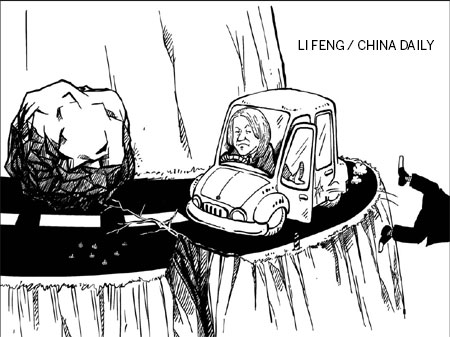
Australian Prime Minister Julia Gillard convincingly won a leadership vote against rival Kevin Rudd on Monday and it is she who will head the Australian Labor Party and government at the election sometime in 2013, or maybe even this year.
Over the coming months there will be analysis after analysis of opinion polls, focus groups and voter demographics by professional pundits. But it seems to me that there is a relatively simple way of looking at the task confronting Gillard and the Coalition opposition leader in their bid to secure the support of the Australian public.
I travel a lot and I have seen many different economies and elections. I think I must have been to 56 countries over the last five years, countries as far apart economically, geographically and politically as Mexico and Mongolia, Malta and Mozambique. And as a self-pronounced "airport economist", it occurs to me that I can understand the electorate in my own country, by observing my home airport of Sydney.
Just think of the potential voters that use the three terminals of Sydney Airport.
In Terminal 1, the international terminal, you have a variety of regular business travellers from corporate Australia. These are a mix of high-income, mainly Liberal voters, but there are also some Labor voters and some Greens. Also in the terminal, though not in the business-class lounges, are young voters, backpackers and students - who traditionally voted Labor, but who are now increasingly supporting the Greens - and Australians from other walks of life travelling overseas for holidays, thanks to a high Australian dollar and increasing Airline competition, whose vote will probably go to the party that seems to promise their dollars will travel furthest.
And let's not overlook the fact that at Terminal 1 there is another major segment of the Australian electorate immigrants. Not only do immigrants go to this terminal to fly to their countries of origin and visit their relatives, or come to the terminal to welcome family members to Australia, take a look around, what do you see?
Who are the cleaners and the servers in the restaurants and the duty-free shops? Who is handling your baggage? Who drives your taxi to the airport? Immigrants, many newly arrived. Which should not come as a surprise, as one in four Australians was born overseas. Sensis data show that 50 percent of our exporters were born overseas. So immigrants do the work and they create the jobs. Their kids and grandkids will go to university and be highly skilled workers. Low and middle-income immigrants traditionally vote Labor.
Next is Terminal 2, the terminal for Virgin and Jetstar and the terminal that serves regional Australia. A lot of National party voters use this terminal to go to Taree and Coffs Harbour, Dubbo and Wagga Wagga. But with the rise in incomes of self-employed and small-business operators a new constituency is up for grabs. Many of these voters would definitely have voted for Bob Hawke and for Paul Keating, but Tony Abbott and John Howard before him have had some success in wooing them. For Gillard, winning Terminal 2 back is crucial to winning the election.
Finally, Terminal 3, this is Qantas domestic, which attracts mainly Corporate Australia. Voter-wise it is similar to the Qantas Club in the International Terminal - professional, middle to high-income, and split between Coalition, Labor and Green but tending to Coalition, of a Malcolm Turnbull small "L" liberal variety.
So here is my advice to Gillard for the election: consolidate Terminal 3, maintain a winning margin in Terminal 1, but make up lost ground in Terminal 2, where the Coalition are campaigning very effectively with Tony Abbott's cut-through style.
The author is the JW Nevile Fellow in Economics, Australian School of Business, The University of New South Wales and author of The Airport Economist.
(China Daily 02/29/2012 page9)